Understanding Earth: what the Cluster mission has taught us so far
8 February 2018
As inhabitants of the third rock from the Sun, we have a vested interest in understanding our home planet and its environment. Among the flotilla of spacecraft that have been sent to investigate Earth from space are the four spacecraft of the Cluster mission. Since 2000, they have been tirelessly gathering vital data about the magnetic environment around our planet and, in the process, about one of the most important relationships in the Solar System: the physical connection between the Earth and the Sun.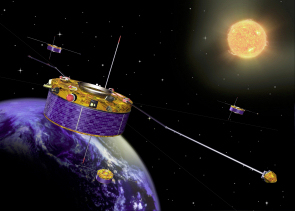 |
| Artist's impression of the Cluster spacecraft. Credit: ESA |
Cluster was the first mission to study the magnetosphere (the region where Earth's magnetic field dominates) in three dimensions and it has provided important clues about how this complex barrier shapes our atmosphere and interacts with the solar wind – the continuous stream of high-energy particles from the Sun.
The Cluster quartet – four identical spacecraft flying in a pyramid configuration – study the physical processes occurring within and around the magnetosphere. To better understand this region is to better understand how life was and is possible on our planet. Cluster data also provide essential insights for safe air travel, space travel and effective satellite communications.
Most missions studying the magnetosphere focus their efforts around the equator where much of the electric currents flow. The Cluster fleet, however, occupies a polar orbit, sweeping the sky from the magnetosphere to interplanetary space while exploring the dynamic polar regions in unprecedented detail. It is in these regions that the most important interactions between the magnetosphere and the solar wind take place.
Cluster's continuous observations, longevity, unique orbit, and changing configuration as a multi-spacecraft mission make it a key instrument in understanding the complex magnetic environment of the Earth and its finely balanced relationship with the Sun. In this article, we present some of the scientific highlights from this remarkable mission.
Highlights in this article
Models and maps of the Earth's magnetosphere
Among Cluster's most notable successes has been in its ability to model and map the Earth's magnetosphere, the region where the solar wind and the Earth's magnetic field interact. The powerful magnetic field the Earth produces has the vital job of shielding the atmosphere and surface of the Earth from the Sun's perpetual bombardment of – at times – dangerous energetic particles, and yet how it behaves is still not well understood. The rise of space travel has made mapping this activity a much more important and pressing matter. The magnetosphere acts as a giant energy reservoir, absorbing energy from the solar wind and expelling it violently during magnetic storms. Predicting these outbursts is key to delivering space missions safely.
In 2014, a study using Cluster data revealed a new model of this mysterious region. The study brought together data from several spacecraft, as well as supporting observations from solar wind probes and ground-based geomagnetic observatories, to develop a model that describes the Earth's magnetic field and its interaction with the solar wind not just theoretically as had been the case previously, but based on actual measurements. Recently, the model has been refined and improved, resulting in even better insight into the structure and dynamics of the magnetosphere close to Earth and in the more distant reaches of the magnetosphere. This kind of global, observation-based, model of the magnetosphere would not have been possible without Cluster's data, which covers much higher latitudes than other missions.
Using Cluster data in another way researchers were also able to map the cold plasma, flowing out from the Earth's atmosphere, in three dimensions and more accurately than ever before, a development with particularly important implications for predicting space weather and the dynamics of the magnetosphere. Cold plasma is made up of slow moving, positively charged particles that are created when the Sun strips atmospheric atoms of their electrons leaving behind their positively charged nuclei. These are thought to play an important role in how the storms affect us. However, prior to the study in question the quantity of cold plasma around the Earth was unknown and very difficult to detect. Spacecraft – whose exterior will also be positively charged for the same reason as the cold plasma – repel the plasma, making it easy to miss.
Using the unique configuration of the four Cluster spacecraft researchers analysed anomalies in the data that resulted from the plasma particles being repelled by, and moving around, each spacecraft. The data showed that cold plasma dominates most of the volume of the magnetosphere at least 50-70% of the time, much more than previously thought, and reaches from the top of Earth's atmosphere to at least a quarter of the distance to the Moon. Taking this extra amount of cold plasma into account when creating models for space weather will much improve their accuracy and fill some of the missing gaps that currently exist in knowledge about how plasma might affect solar storms.
Mysteries of the magnetosphere
| Full orbit of the Cluster space fleet over a simulated Earth's magnetosphere responding to the Sun's activity. Credit: ESA. Click here for further details and larger versions of this video. |
Mapping Earth's complex magnetosphere has also led to new insights about the dynamics of what is known at the magnetotail – the region of the magnetosphere that extends beyond the Earth, away from the Sun. The magnetotail consists of two lobes – northern and southern – containing very few particles and separated by a plasma sheet. This sheet has a much higher density of charged particles than the lobes and a magnetic field which, while weaker, varies hugely in amplitude. For a long time it has been theorised that these variations are caused by oscillations in the sheet's current but the origins of the oscillations were unknown. In 2004, data from Cluster revealed the origins of the oscillations for the first time and proved that they are not, like so much else in the magnetosphere, caused by external influence but by internal processes. The researchers found waves (dubbed kink-like waves) at the centre of the tail with properties unlike any seen before. These waves are emitted and propagate outwards causing the oscillations observed.
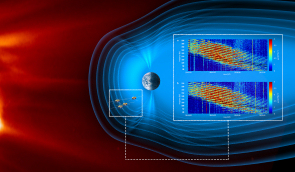 |
| Cluster observes the structure of equatorial noise. Credit: ESA/ATG medialab |
The mysterious oscillation of the magnetotail's plasma sheet is not the only mystery to be solved by Cluster. In 2015 an international team of scientists set out specifically to solve a fifty-year-old magnetosphere mystery. The mystery at hand was equatorial noise: noisy plasma waves located close to the equatorial plane of Earth's magnetic field. The waves were first observed in 1966 and have since become the most frequently observed waves by spacecraft in the region, yet no one had the evidence for a robust theory of their structure or where they came from – until 2015. When this evidence finally came, the equatorial noise turned out to be far from noisy. In fact, Cluster observations revealed a highly structured and periodic pattern, much more coherent and structured than most plasma waves. The well organised spectroscopic pattern matched the frequencies of protons moving in a circular motion in a uniform magnetic field and thus confirmed that the waves are generated by protons. To get this result required observations over distance and time that were only possible with Cluster's unique configuration and this gave the answers to a mystery that has eluded researchers for half a century.
New view of the solar wind
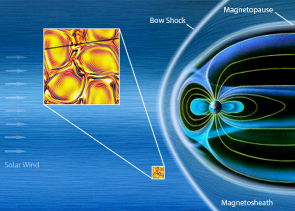 |
| Turbulent swirls in the solar wind. Credit: Background graphic: ESA/ATG Medialab; inset: J. Dorelli (NASA) |
Cluster not only turns its attention to the Earth's magnetosphere, but also to the external factors that shape it. Key to this is the solar wind, a stream of electrically charged atomic particles, known as plasma, which is ejected by the Sun and travels across the Solar System, carrying its own magnetic field with it. The solar wind travels at speeds of up to 2000 kilometres per hour and reaches temperatures of one million degrees Celsius. Cluster has been used to probe the detail of this wind, zooming in to reveal fine details in the plasma's dynamics and to make extremely detailed observations. One resulting discovery from this zooming in on the Sun's destructive wind is that there are swirls of turbulence within it, even on a very small scale. This turbulence arises from irregularities in the flow of particles and magnetic field lines.
The turbulence was uncovered using just two of the four Cluster satellites and showed for the first time that the solar wind plasma is extremely structured at this high resolution with turbulent swirls bordered by a sheet of electric current just 20 kilometres across. This small-scale phenomena has a big effect on how the plasma behaves and it is thought to be these cascades of energy that contribute to the overall heating of the solar wind.
More a sieve than a barrier
New insights into the magnetosphere and the solar wind are a key output of the Cluster mission, but it is in studying the interactions between the two that the mission really makes it mark.
Cluster has redefined how we think about the magnetosphere with the discovery that, when it comes to the solar wind, our trusted shield is more a sieve than a barrier and is penetrated in numerous places, and in numerous ways, by the solar wind's onslaught of charged particles.
It has been known for some time that there are locations on the outer region of the magnetosphere, known as the magnetopause, where the solar wind particles are able to penetrate. This occurs at points where the Earth's magnetic field and the magnetic field of the Sun – the interplanetary magnetic field – are pointing in opposite directions; one to the south, the other to the north. At these points a process known as reconnection, where field lines break and reconnect to others around them, takes place, essentially creating a door in the magnetopause for the solar wind particles to enter through. This explains the presence of reservoirs of high-energy particles under these areas in the magnetopause but for some time scientists remained puzzled as to why these reservoirs are also found in areas where the two magnetic fields at the magnetopause are aligned and should therefore create an impenetrable barrier.
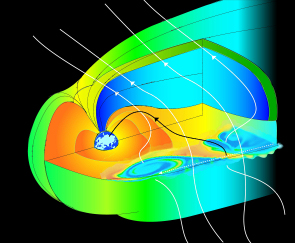 |
| 3D view of Earth's magnetosphere with Kelvin Helmholtz vortices. Credit: H. Hasegawa (Dartmouth College) |
It was in 2004 that Cluster solved this mystery when researchers discovered giant vortices of gas at the magnetopause boundary in areas where the Earth and interplanetary magnetic field lines were aligned. These huge swirls of plasma are formed by what are known as Kelvin-Helmholtz waves, which occur when two flows of material are aligned but travelling at different speeds causing them to slip past one another. This results in vortices of material up to 40 000 kilometres across containing superheated material with the energy to drill through the magnetopause.
These finding have been further developed since, most notably in 2012 with the discovery of Kelvin-Helmholtz waves at other latitudes and orientations of the interplanetary magnetic field, and further analysis of the spatial structures and characteristics of them.
Complementing these findings, Cluster scientists have gained startling new insights into reconnection, the more established process for penetration of the magnetosphere. In reconnection, two parallel field lines with fields pointing in opposite directions collide, snap, and reconnect to form an entirely new magnetic topography which, in the case of the magnetopause, creates an open door for the solar wind to penetrate. Despite being key to many theories and observations the heart of this physical process, the point where the magnetic field lines break and reform, had not been observed in situ until 2006. The restricting factor for making this observation was that you need at least four simultaneous observations in order to characterise it, a functionality that only Cluster could provide. Using Cluster, scientists have now successfully characterised this point, known as the magnetic null, in three dimensions and its physical properties and topology have been described for the first time – in this case with a spatial extent of 500 kilometres.
In 2017, scientists reported another surprising finding made with Cluster data: contrary to the consensus at the time, most of the energy dissipated during a reconnection event is not released at the crossings, or X-lines, between the two plasma flows but rather in swirling vortices, or O-lines, where magnetic field lines bundle up and spiral together. The finding is an important step in the process of understanding the mechanisms that accelerate particles in space plasma.
| Violent explosions on the Sun can lead to killer electrons in the near-Earth space environment. Credit: ESA. Click here for further details and larger versions of this video. |
Although there are several ways through the magnetopause and the potential damage of the solar wind is undeniable, some of the most dangerous particles in the magnetosphere don't come from outside but are formed from within. The aptly named highly energetic particles known as killer electrons, found in Earth's outer radiation belt, are some of the most disruptive in the magnetosphere and can cause havoc for satellites. Luckily, satellite orbits can be adjusted to avoid these belts, or their key technology can be shut down when they transit through, but during solar storms the number of killer electrons swells and they can relocate, potentially causing mayhem. In 2004 scientists finally disentangled what causes these killer electrons to occur when Cluster observed the process first hand. They found that first, a shock wave from a solar storm hits the Earth's magnetic field causing it to compress and accelerate electrons within the magnetosphere. Then, immediately afterwards, Earth's magnetic field lines vibrate at ultra-low frequencies to further accelerate the electrons – and all that can happen in just 15 minutes. This discovery is key to improving the predictions about radiation in near-Earth space that keep satellites and astronauts safe.
Cluster may have shown us the dangers within the magnetosphere, and that it is not quite as impenetrable as we once thought, but the shielding effect that our magnetic field affords us should not be undervalued. Indeed, in 2012 Cluster worked with Mars Express to compare the effects of the same gust of solar wind on the atmospheres of Mars and Earth and found that Earth's magnetic field is essential for keeping our atmosphere in place. Observing both planets during a chance alignment showed that Mars' atmosphere lost oxygen at a rate ten times that of Earth, a difference which, over time, could explain some of the differences in atmosphere between the two planets and why ours was able to foster life.
Understanding auroras
Knowledge about the relationship between the magnetosphere and the solar wind, and the mechanisms by which plasma travels across the magnetopause is key to understanding the processes behind space weather phenomena such as magnetic storms and auroras. Auroras are among the most famous features of our skies, and they are certainly a stunning visual display of the Sun's effect on Earth, but they are still not well understood. Cluster has, however, helped to shed light on some of their mysterious behaviours.
Auroras are a consequence of the solar wind penetrating the magnetopause when magnetic reconnection occurs. These high-energy particles then travel along Earth's magnetic field lines and strike atoms high in the atmosphere creating the light displays we see from the surface.
Viewers are most likely to catch this display at 65-70 degrees north or south of the equator, encircling the polar caps in a region known as the auroral oval. However, if the Sun's magnetic field arrives at Earth with a certain orientation aurora can occur at higher latitudes, and the origin of these auroras are much less understood. In 2014 Cluster worked with NASA's IMAGE satellite to explain the workings of very high latitude auroras known as "theta auroras".
| Formation of a theta aurora. Credit: ESA/NASA/R. Fear et al (2014). Click here for further details and larger versions of this video. |
With the Cluster satellites located in the southern hemisphere magnetic lobe, and the IMAGE spacecraft having a wide-field view of the southern hemisphere, aurora researchers observed the phenomena more fully than ever before and could finally reveal its origin. They discovered that the lobe, an area of the magnetosphere which is usually filled with cold, unenergetic, plasma, does in some cases fill up with hot plasma when magnetic reconnection occurs on the night side of the Earth, thus closing the field lines and trapping the plasma within. Because the field lines are closed the solar wind can no longer enter and yet, as Cluster observed this strangely energetic plasma IMAGE simultaneously observed the theta aurora, proving the build-up of hot plasma to be the origin of these rare auroras.
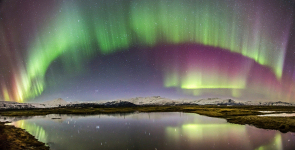 |
| Aurora over Icelandic lake. Credit: C. Gauna |
| Black aurora near Tromsø. Credit: Video courtesy of Michael Kosch. Click here for more details. |
This is not the only aurora mystery that Cluster has unravelled. In 2015 Cluster revealed, for the first time, the relationship between the bright auroras we are familiar with and the less familiar black auroras, the dark patches which stretch between their colourful cousins. In 2001 Cluster made the first ever observations of the dark auroras and revealed that the electron population of the ionosphere – the ionised region of the atmosphere where the auroras occur – becomes depleted in these dark regions. These black auroras are not the result of particles entering our atmosphere down magnetic field lines and striking atoms, as is the case with coloured auroras, but of particles escaping in the other direction, emptying the ionosphere as they go. Fourteen years later, in 2015, scientists were able to use Cluster to develop the first accurate model of the electric fields and currents within black auroras and to demonstrate the relationship between the currents that bring particles from the magnetosphere to the ionosphere – creating auroras – and those that suck the particles from the ionosphere to the magnetosphere – creating dark auroras.
Understanding how the magnetosphere and ionosphere exchange particles is not just an exercise in satisfying curiosity. Changes in the number of electrons in the ionosphere can affect GPS signals reducing the accuracy of their navigation and timing, and have an impact on the radar and radio communications of aircraft flying over the North Pole. Understanding the ionosphere and being able to make predictions using models like those developed with Cluster is vital in our modern society.
Clues to a life-giving atmosphere
Cluster has shown that the Earth's magnetic field plays a vital role in keeping our atmosphere in place and allowing life to thrive, but how particles move within the magnetosphere, and where the plasma within it comes from, are equally important to understand and this too has been probed by the Cluster quartet.
We know that the magnetosphere is filled with plasma from solar wind but for more than two decades it has been theorised that the innermost part of the Earth's magnetosphere – a region centred around the Earth's equator and surrounding our planet's atmosphere known as the plasmasphere – also plays a vital role in replenishing the outer magnetosphere with fresh plasma. Understanding how this atmospheric material escapes is crucial to understanding how life developed on our planet, and to finding life on others.
| Animation of the plasmaspheric wind. Credit: ESA/ATG medialab. Click here for further details and larger versions of this video. |
Until 2013 the flow of plasma from the plasmasphere to the outer magnetosphere had only been observed in short bursts, known as plumes, which, even combined with the biggest contributor of plasma to our magnetosphere – the solar wind – could not account for the replenishment of plasma predicted in models. It was the capabilities of Cluster that enabled scientists to resolve this issue. Cluster data were used to identify a leakage of material from the plasmasphere outwards – a leak that constantly transfers material to the magnetosphere. Rather than looking just at plumes of material, there is now evidence of a steady wind of plasma from plasmasphere to magnetosphere, transferring almost 90 tonnes of plasma each day. This research was further built upon in 2016 using Cluster data to compare the steady leakage of Earth's atmosphere with the sporadic plumes that emanate from the plasmasphere.
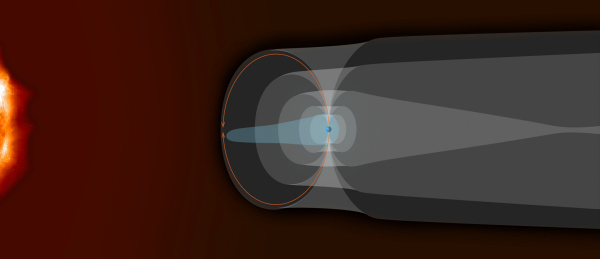 |
| Where does Earth's leaking atmosphere go? Credit: ESA/ATG medialab |
Understanding the behaviour of our atmosphere is key to untangling the conditions for life. We know that planetary atmospheres play an essential role in rendering a planet habitable or lifeless and to find the potential for life in atmospheres elsewhere, we first need to understand our own.
